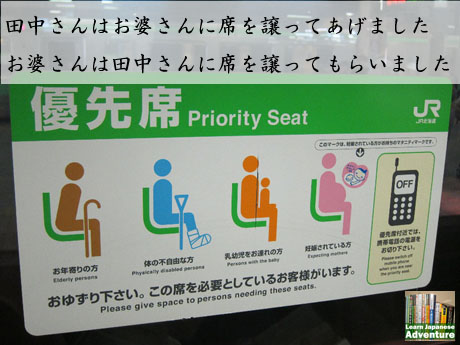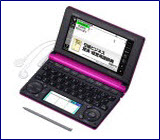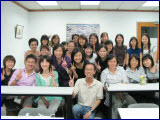- Home
- Intermediate Lessons
- Giving and Receiving of Actions in Japanese Part 2
Giving and Receiving of Actions in Japanese
~てあげる ~てもらう ~てくれる Part 2 -
Intermediate Lessons: 38
This lesson is part 2 of the previous lesson. I will show you many different examples on how to use ~てあげる, ~てもらう and ~てくれる for giving and receiving of "actions" (deeds).

Depending on the verbs used for the actions, you will also learn what are the specific particles used in these examples.
Let's check out the sentence patterns for ~てあげる, ~てもらう and ~てくれる.
Sentence Pattern of ~てあげる
| The person who gives assistance |
は | The person who receives assistance |
を/ に Noun を/ の Noun を |
て-form あげます |
Sentence Pattern of ~てくれる
| The person who gives assistance |
は | The person who receives assistance |
を/ に Noun を/ の Noun を |
て-form くれます |
| Third Person | → | Me/My Family | ||
| My Family | → | Me |
Sentence Pattern of ~てもらう
| The person who receives assistance |
は/が | The person who gives assistance |
に | て-form もらいます |
| X Me | ||||
| X Third Person | → | My Family |
You will see that for ~てあげる and ~てくれる sentences, the person who receives the assistance can be marked by particle に, の or を, all depending on the verbs used.
This is the most difficult part when using these sentence patterns as many of you always get confused about which particle to use.
To determine which particle to use, you have got to understand the verb involved in the sentence. Most verbs are tied to specific particle.
To help you on this, I will show you about 20 verbs together with some examples. Memorize the formats of all of them if you need to. This will help you determine the correct particle once you see similar verbs.
On the other hand in ~てもらう sentence, the action taker is always marked by the particle に. Therefore you will see only the following pattern for ~てもらう sentence...
| Action Receiver | は | Action Taker | に | て-form もらいます |
20 Verbs with Example Sentences
1. Person に Noun を 見せる
見せる (miseru) means to show. When using this verb, the format is always
"Person に Noun を 見せる". For example,
- 私は友達に写真を見せます。
watashi wa tomodachi ni shashin wo misemasu
Meaning: I show the photos to my friend.
Using the above sentence pattern, you just need to change the verb 見せる (miseru) to て-form and add in あげます. It becomes...
- 私は友達に写真を見せてあげます。
watashi wa tomodachi ni shashin wo misete agemasu
Meaning: I show the photos to my friend.
In the above example, the Giver is 私 (the speaker), the Receiver is 友達. Since the Giver is 私, you cannot use the ~てもらう sentence.
Therefore the following example is not accepted, although grammatically there's no mistake.
- 友達は私に写真を見せてもらいます。 X
tomodachi wa watashi ni shashin wo misete moraimasu X
2. Person に Noun を 教える
教える (oshieru) means to teach, to inform, to tell. Similar to the previous example the format is "Person に Noun を 教える".
With the above sentence patterns, you will see the following examples...
Giver is 先生. Receiver is 私達.
- 先生は私達に日本語を教えてくれました。
sensei wa watashitachi ni nihongo wo oshiete kuremashita
Meaning: Teacher taught us Japanese.
- 私達は先生に日本語を教えてもらいました。
watashitachi wa sensei ni nihongo wo oshiete moraimashita
Meaning: Teacher taught us Japanese.
3. Person に Noun を 貸す
貸す (kasu) means to lend.
Format is "Person に Noun を 貸す".
Giver is 兄. Receiver is 弟.
- 兄は弟にお金を貸してあげました。
ani wa otouto ni okane wo kashite agemashita
Meaning: My elder brother lent money to my younger brother.
- 弟は兄にお金を貸してもらいました。
otouto wa ani ni okane wo kashite moraimashita
Meaning: My elder brother lent money to my younger brother.
4. Person に 席 を 譲る
譲る (yuzuru) means to hand over, to transfer, to relinquish, to give up.
Format is "Person に Noun を 譲る".
Giver is 田中さん. Receiver is お婆さん.
- 田中さんはお婆さんに席を譲ってあげました。
tanaka san wa obaasan ni seki wo yuzutte agemashita
Meaning: Mr Tanaka gave up his seat to the old lady.
- お婆さんは田中さんに席を譲ってもらいました。
obaasan wa tanaka san ni seki wo yuzutte moraimashita
Meaning: Mr Tanaka gave up his seat to the old lady.
5. Person に Noun を 作る
作る tsukuru) means to make, to create.
Format is "Person に Noun を 作る".
Giver is 母. Receiver is 私.
- 母は私にご飯を作ってくれました。
haha wa watashi ni gohan wo tsukutte kuremashita
Meaning: My mother made a meal for me.
- 私は母にご飯を作ってもらいました。
watashi wa haha ni gohan wo tsukutte moraimashita
Meaning: My mother made a meal for me.
6. Person に Noun を 買う
買う (kau) means to buy.
Format is "Person に Noun を 買う".
Giver is 父. Receiver is 妹.
- 父は妹にアイスクリームを買ってあげました。
chichi wa imouto ni aisukuri-mu wo katte agemashita
Meaning: My father bought ice-cream for my younger sister.
- 妹は父にアイスクリームを買ってもらいました。
imouto wa chichi ni aisukuri-mu wo katte moraimashita
Meaning: My father bought ice-cream for my younger sister.
7. Person を 迎える
迎える (mukaeru) means to welcome, to greet, to meet, to pick up.
Format is "Person を 迎える".
Giver is 家族. Receiver is 私.
- 家族は私を車で迎えてくれました。
kazoku wa watashi wo kuruma de mukaete kuremashita
Meaning: My family picked me up by car.
- 私は家族に車で迎えてもらいました。
watashi wa kazoku ni kuruma de mukaete moraimashita
Meaning: My family picked me up by car.
8. Person を 送る
送る (okuru) means to send (a thing), to take (a person somewhere), to see off (a person).
Format is "Person を 送る".
Giver is 兄. Receiver is 私.
- 兄は私を駅まで送ってくれました。
ani wa watashi wo eki made okutte kuremashita
Meaning: My elder brother took me to the train station.
- 私は兄に駅まで送ってもらいました。
watashi wa ani ni eki made okutte moraimashita
Meaning: My elder brother took me to the train station.
9. Person を 待つ
待つ (matsu) means to wait.
Format is "Person を 待つ".
Giver is 水野さん. Receiver is 田中さん.
- 水野さんは田中さんを待ってあげました。
mizuno san wa tanaka san wo matte agemashita
Meaning: Mr Mizuno waited for Mr Tanaka.
- 田中さんは水野さんに待ってもらいました。
tanaka san wa mizuno san ni matte moraimashita
Meaning: Mr Mizuno waited for Mr Tanaka.
10. Person を Noun に 誘う
誘う (sasou) means to invite, to ask.
Format is "Person を Noun に 誘う".
Giver is 山田さん. Receiver is 私.
- 山田さんは私をダンスに誘ってくれました。
yamada san wa watashi wo dansu ni sasotte kuremashita
Meaning: Mr Yamada invited me for a dance.
- 私は山田さんにダンスに誘ってもらいました。
watashi wa yamada san ni dansu ni sasotte moraimashita
Meaning: Mr Yamada invited me for a dance.
11. Person を Noun に 招待する
招待する (shoutai suru) means to invite, to entertain.
Format is "Person を Noun に 招待する".
Giver is 友達. Receiver is 弟.
- 友達は弟を結婚式に招待してくれました。
tomodachi wa otouto wo kekkonshiki ni shoutaishite kuremashita
Meaning: My friend invited my younger brother to the wedding ceremony.
- 弟は友達に結婚式に招待してもらいました。
otouto wa tomodachi ni kekkonshiki ni shoutaishite moraimashita
Meaning: My friend invited my younger brother to the wedding ceremony.
12. Person を Place へ 連れて行く
連れて行く (tsurete iku) means to take someone (of lower status) along.
Format is "Person を Noun へ 連れて行く".
Giver is 父. Receiver is 妹.
- 父は妹をデパートへ連れて行ってあげました。
chichi wa imouto wo depa-to e tsureteitte agemashita
Meaning: My father took my younger sister to the department store.
- 妹は父にデパートへ連れて行ってもらいました。
imouto wa chichi ni depa-to e tsureteitte moraimashita
Meaning: My father took my younger sister to the department store.
13. Person の Noun を 掃除する
掃除する (souji suru) means to clean, to sweep.
Format is "Person の Noun を 掃除する".
Giver is 母. Receiver is 妹.
- 母は妹の部屋を掃除してあげました。
haha wa imouto no heya wo soujishite agemashita
Meaning: My mother cleaned my younger sister's room.
- 妹は母に部屋を掃除してもらいました。
imouto wa haha ni heya wo soujishite moraimashita
Meaning: My mother cleaned my younger sister's room.
14. Person の Noun を 洗濯する
洗濯する (sentaku suru) means to wash, to clean (laundry).
Format is "Person の Noun を 洗濯する".
Giver is 姉. Receiver is 私.
- 姉は私のシャツを洗濯してくれました。
ane wa watashi no shatsu wo sentakushite kuremashita
Meaning: My elder sister washed the shirt for me.
- 私は姉にシャツを洗濯してもらいました。
watashi wa ane ni shatsu wo sentakushite moraimashita
Meaning: My elder sister washed the shirt for me.
15. Person の Noun を 撮る
撮る (toru) means to take (a photo).
Format is "Person の Noun を 撮る".
Giver is 木村さん. Receiver is 田中さん.
- 木村さんは田中さんの写真を撮ってあげました。
kimura san wa tanaka san no shashin wo totte agemashita
Meaning: Mr Kimura took a picture for Mr Tanaka.
- 田中さんは木村さんに写真を撮ってもらいました。
tanaka san wa kimura san ni shashin wo totte moraimashita
Meaning: Mr Kimura took a picture for Mr Tanaka.
16. Person の Noun を 直す
直す (naosu) means to fix, to correct, to repair.
Format is "Person の Noun を 直す".
Giver is 父. Receiver is 山田さん.
- 父は山田さんの自転車を直してあげました。
chichi wa yamada san no jitensha wo naoshite agemashita
Meaning: My father repaired the bicycle for Mr Tanaka.
In this example, the Giver is 父 (My family) and the Receiver is 山田さん (Third person). According to the sentence pattern above, you cannot use the ~てもらう sentence in this situation.
Therefore the following example is not accepted, although grammatically there's no mistake.
- 山田さんは父に自転車を直してもらいました。 X
yamada san wa chichi ni jitensha wo naoshite moraimashita X
Meaning: My father repaired the bicycle for Mr Tanaka.
17. Person の Noun を 持つ
持つ (motsu) means to hold, to carry, to possess.
Format is "Person の Noun を 持つ".
Giver is 兄. Receiver is 私.
- 兄は私の鞄を持ってくれました。
ani wa watashi no kaban wo motte kuremashita
Meaning: My elder brother carried the bag for me.
- 私は兄に鞄を持ってもらいました。
watashi wa ani ni kaban wo motte moraimashita
Meaning: My elder brother carried the bag for me.
18. Person の Noun を 叩く
叩く (tataku) means to hit, to strike, to beat.
Format is "Person の Noun を 叩く".
Giver is 娘. Receiver is 私.
- 娘は私の肩を叩いてくれました。
musume wa watashi no kata wo tataite kuremashita
Meaning: My daughter gave me a massage on my shoulder.
- 私は娘に肩を叩いてもらいました。
watashi wa musume ni kata wo tataite moraimashita
Meaning: My daughter gave me a massage on my shoulder.
19. Person の Noun を 手伝う
手伝う (tetsudau) means to help, to assist.
Format is "Person の Noun を 手伝う".
Giver is 妹. Receiver is 母.
- 妹は母の皿洗いを手伝ってあげました。
imouto wa haha no saraarai wo tetsudatte agemashita
Meaning: My younger sister helped my mother for the dish washing.
- 母は妹に皿洗いを手伝ってもらいました。
haha wa imouto ni saraarai wo tetsudatte moraimashita
Meaning: My younger sister helped my mother for the dish washing.
20. Person の Noun を 運ぶ
運ぶ (hakobu) means to transport.
Format is "Person の Noun を 運ぶ".
Giver is 友達. Receiver is 私.
- 友達は私の荷物を運んでくれました。
tomodachi wa watashi no nimotsu wo hakonde kuremashita
Meaning: My friend carried (transported) the luggage for me.
- 私は友達に荷物を運んでもらいました。
watashi wa tomodachi ni nimotsu wo hakonde moraimashita
Meaning: My friend carried (transported) the luggage for me.
Conclusion
The actual meaning of a sentence with or without ~てあげる / ~てもらう / ~てくれる is the same, except that the former show that the Action Receiver is grateful for what the Action Taker has done for him/her.
Another point to note is that for ~てあげる and ~てくれる sentences, the focus is on the Action Taker. Whereas for ~てもらう sentence, the focus is on the Action Receiver.
For ~てもらう sentence, the Action Taker is always marked by the particle に.
However, for ~てあげる and ~てくれる sentences, the Action Receiver can be marked by the particles に, の or を, depending on the verbs used.
Related Page
Basic Lesson 20: Japanese Verbs Give & Receive.
Best Deal of the Year! Get 68% OFF Lifetime Premium! Ends on 13 Dec 2025
Click Here to Get 68% OFF Lifetime Premium and be on the fast track to fluency in Japanese.
The link above is an affiliate link, which means that I would earn a commission (at no extra cost to you) if you do end up purchasing the related learning course.
Buy me a coffee









Facebook Comments
Don’t see the comments box? Log in to your Facebook account, give Facebook consent, then return to this page and refresh it.